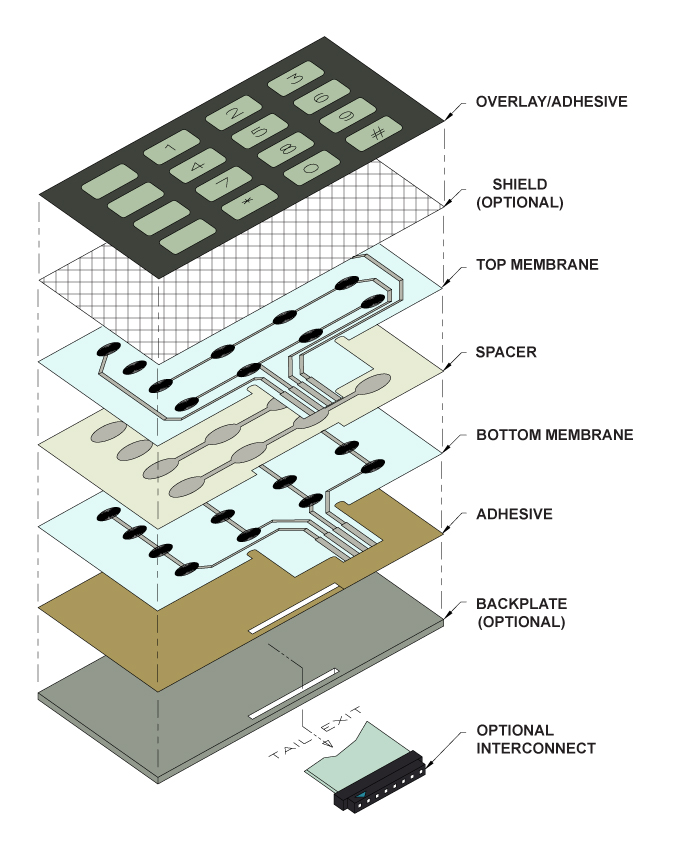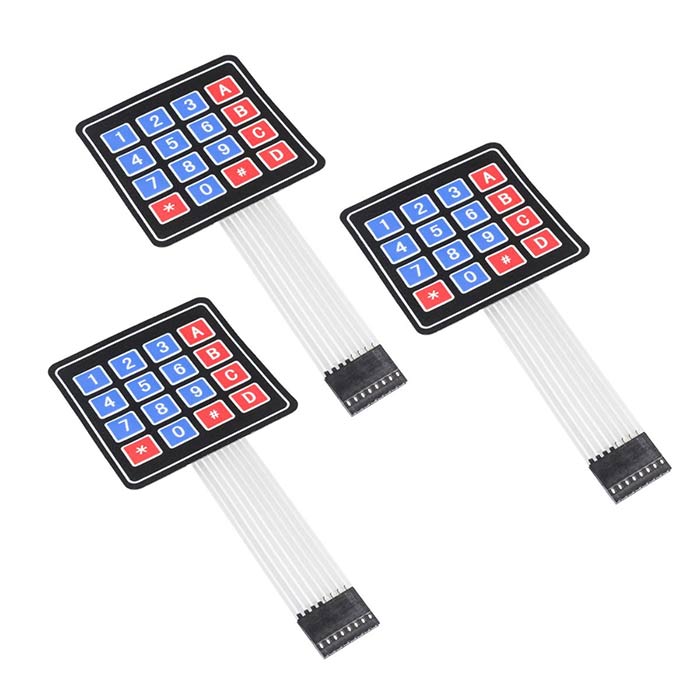Everything About Membrane Layer Switch: Understanding Its Layout and Capability
When you think of the control interfaces in modern devices, membrane layer switches usually come to mind. These parts are greater than simply buttons; they blend style and functionality seamlessly. Understanding how they function and what makes them effective can alter your perspective on day-to-day electronics. However, there are nuances to their layout and efficiency that you might not understand. Let's discover what collections membrane layer switches besides various other control systems.
What Are Membrane Layer Switches?

Their smooth nature makes them simple to clean and immune to dust and moisture, an important attribute in lots of environments. Membrane switches can additionally be customized pertaining to form, dimension, and graphics, allowing makers to develop unique interfaces customized to details products. And also, they're light-weight and slim, which aids in lessening the total bulk of tools. Generally, membrane switches play a substantial function in boosting customer experience across a vast range of applications.
Just How Membrane Layer Changes Job
When you push a secret on a membrane switch, it triggers a straightforward yet effective device. membrane switch manufacturer. The top layer, often made of flexible material, presses down onto a conductive layer under it.
You'll observe that the tactile responses differs based on the button design, supplying either a soft click or a more pronounced reaction. As soon as you release the trick, the membrane returns to its original setting, reopening the circuit and stopping the signal. This procedure occurs almost immediately, ensuring a responsive user experience.
Membrane switches are prominent because of their longevity and resistance to dust and dampness, making them excellent for numerous applications, from household appliances to clinical tools. Comprehending this procedure helps you value their extensive use.
Key Components of Membrane Switches
Understanding the essential elements of membrane switches is basic for grasping their functionality and style. At the core, you'll discover the graphic overlay, which supplies the visual user interface for users. Under that, there's a spacer layer that separates the circuit layers, ensuring that they don't make contact until pushed. The circuit layer is where the magic takes place; it contains conductive traces that complete the circuit when you push the switch. Another vital aspect is the sticky support, permitting the button to stick to surfaces firmly. The safety layer guards against ecological elements and put on, expanding the button's life expectancy. Each element plays a considerable role in guaranteeing trustworthy efficiency and user interaction. By recognizing these components, you'll obtain understanding into how membrane switches over operate and their relevance in different applications.
Materials Made Use Of in Membrane Change Design
The efficiency and sturdiness of membrane layer changes heavily depend on the products utilized in their layout. You typically run into polyester and polycarbonate as key substrates because of their excellent strength and versatility. These materials withstand scratches and chemicals, making them suitable for requiring environments.
The conductive layers commonly make use of silver or carbon, chosen for their dependability and conductivity. membrane switch manufacturer. Silver provides premium performance, while carbon is an economical option. For the overlay, you may take into consideration a matte or glossy surface, depending upon your aesthetic requirements and individual experience
Make specific to choose adhesives that endure environmental aspects like temperature and humidity. Choosing the right materials will guarantee your membrane layer switch stands the test of time.
Design Considerations for Membrane Layer Switches
While making membrane buttons, it's crucial to consider various variables that affect their functionality and customer experience. Start by concentrating on the format and switch dimension; make particular they're intuitive and simple to navigate. Think about the responsive responses you wish to offer-- will users require a noticeable click or a softer touch? Furthermore, think of the products you'll use, as they'll affect longevity and aesthetic appeals.
Do not overlook the graphic design; clear labeling and color comparison are substantial for visibility. Confirm your style suits ecological variables, like wetness or temperature level variations, which might affect efficiency. Keep in mind the value of screening prototypes with real individuals to collect feedback and make required adjustments. This iterative process aids you improve the layout, verifying it meets both functional and aesthetic demands effectively. By thoroughly considering these aspects, you'll create a membrane button that enhances usability and satisfaction.
Applications of Membrane Buttons
Membrane buttons are functional elements discovered in different applications, from commercial equipment to customer electronics. You'll see their influence in devices that require sturdy interfaces and in gadgets that take advantage of smooth designs. Comprehending these applications assists you appreciate the capability and usefulness of membrane switches in daily modern technology.
Industrial Equipment Usage
When you're aiming to improve the functionality of industrial devices, membrane layer switches supply a reputable option that incorporates resilience with user-friendly layout. These buttons are best for severe atmospheres, giving resistance to dust, dampness, and chemicals. You'll find them in control panels for making machines, cooling and heating systems, and clinical devices, where accuracy and responsiveness are crucial. Their low profile implies they fit effortlessly into different equipment, conserving valuable area while maintaining simplicity of usage. With adjustable graphics and backlighting choices, you click to read more can produce an instinctive user interface for drivers, enhancing effectiveness and safety and security. Plus, their long life-span minimizes maintenance costs, making them a wise financial investment for your commercial applications. Embrace membrane switches to enhance your procedures and improve general efficiency.
Customer Electronic Devices Assimilation
In the domain of consumer electronics, membrane layer buttons play a necessary duty in boosting customer communication and gadget capability. You'll find them in devices like microwaves, push-button controls, and video gaming consoles, providing a seamless method to connect with modern technology. Their smooth design permits easy integration right into numerous products, making controls intuitive and user-friendly. With their capacity to include graphics and backlighting, you can enjoy a modern aesthetic that matches the tool's overall look. Membrane buttons likewise guarantee resilience and resistance to dust and moisture, expanding the life-span of your electronics. By picking membrane switches, you enhance not simply the capability however additionally the style of your gadgets, making daily interactions smooth and satisfying.
Benefits and Negative Aspects of Membrane Layer Switches
While membrane switches supply an array of benefits, they likewise come with some drawbacks that you ought to think about. One considerable benefit is their compact style, making them ideal for space-constrained applications.

Membrane layer buttons can have a much shorter life expectancy compared to mechanical switches, especially under heavy use. They can also be much less responsive, which could influence user feedback throughout procedure. Balancing these pros best site and cons will aid you determine if membrane layer buttons are the right fit for your project.
Frequently Asked Questions
For How Long Do Membrane Switches Over Normally Last?
Membrane layer switches over normally last in between 5 to 10 years, depending upon usage and ecological conditions. You'll want to assess factors like wear, direct exposure to moisture, and temperature level changes to assess their durability efficiently.
Can Membrane Switches Be Customized for Details Layouts?
Yes, you can personalize membrane switches to fit particular layouts (membrane switch manufacturer). You'll have the liberty to select shades, forms, and layouts that match your task's demands, ensuring they mix seamlessly with your general visual
What Is the Price Range for Membrane Switch Over Manufacturing?
The expense range for membrane button production commonly falls between $1 and $10 per device, depending on factors like design intricacy, amount, and products. You can get quotes from producers to locate the most effective choice.

Are Membrane Layer Changes Water Resistant or Immune?
Membrane switches can be designed to be water resistant or immune, relying on materials utilized and building techniques. If you need them for damp atmospheres, assure you specify those demands throughout the style process.
Exactly How Do Membrane Layer Switches Contrast to Traditional Buttons?
Membrane layer buttons are normally thinner and a lot more adaptable than traditional buttons, using a streamlined layout. They're often simpler to clean up and integrate, but may not offer the tactile comments you're made use of to with mechanical alternatives.
Verdict

Comments on “The services offered by a specialized membrane switch manufacturer go beyond standard-level production.”